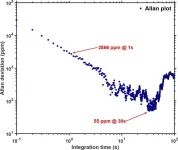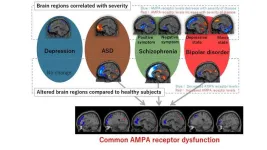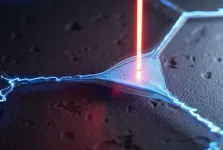(Press-News.org) INDIANAPOLIS – A commentary, published in the Journal of Neurotrauma, calls for traumatic brain injury to be recognized as a chronic condition as are diabetes, asthma, depression and heart failure.
To provide comprehensive care for traumatic brain injury throughout individuals’ lifespans, the authors propose that coordinated care models they and others have developed, tested and applied to various populations -- including older adults, individuals living with depression and post-intensive care unit survivors -- be adapted to improve communication and integration between brain injury specialists -- including physical medicine and rehabilitation clinicians -- and primary care physicians, fostering better long-term patient care for traumatic brain injury survivors and more support for both patients and their families.
The incidence of traumatic brain injury (frequently referred to as TBI) is rising in the U.S., with an estimated 2.8 million Americans receiving a traumatic brain injury each year. The healthcare system and insurance coverage predominantly focus on the acute phase of the condition, typically the first year after the injury is sustained. But for a significant number of those living with a traumatic brain injury, the effects are long lasting, occurring for a lifetime. Post-acute care options, however, are often rather bleak.
Traumatic brain injury is most commonly caused by falls (especially in older adults), blunt trauma (particularly sports-related injuries), firearms, motor vehicles or assaults. Damage can be confined to one area of the brain or it can occur over a more widespread area. Many factors including the size, severity and location of the brain injury as well as age of the individual and prior brain injuries impact recovery.
According to the Centers for Disease Control and Prevention, populations more likely to be affected by traumatic brain injury include:
racial and ethnic minorities
service members and veterans
people who experience homelessness
people who are in correctional and detention facilities
survivors of intimate partner violence
people living in rural areas
The commentary authors observe that many clinicians believe that residual impairments due to traumatic brain injury are static once initial recovery has plateaued and do not expect significant changes over the remainder of a person's life. In contrast, the commentary authors write that the long-term course of traumatic brain injury involves waxing and waning and thus could be better characterized as dynamic rather than static. Accordingly, they call for traumatic brain injury to be considered and managed as a chronic condition.
“Acknowledging traumatic brain injury as a chronic condition and providing coordinated care will make a difference to patients, their families and to how the healthcare system operates in several ways. It recognizes that for many patients it's not over after 12 months and, importantly, provides these patients with a place of care where they can be monitored and helped over many years,” said commentary senior author Kurt Kroenke, M.D. of the Regenstrief Institute and the Indiana University School of Medicine.
“Recognizing TBI as a chronic condition and using coordinated care models support the important role of self-management for both the patient and their family. These two steps facilitate collaboration between the limited number of brain care specialists and the primary care clinicians who typically oversee care throughout the TBI survivor’s lifetime. Collaborative care models, which we at Regenstrief Institute and others have developed, provide patients living with chronic conditions with the support and coordinated care they need. Medicare recently recognized TBI as one of 18 chronic conditions, hopefully others will follow.”
Dr. Kroenke notes that the chronic condition designation by Medicare opens the door to change in how traumatic brain injury is managed long-term and may guide healthcare systems to better integrate brain injury specialists -- who are in short supply -- with primary care providers through collaborative care models. It may also encourage health insurers to provide coverage for the many years of care needed by some survivors.
“We can improve life after brain injury with a more proactive approach and a longer-term view of brain injury as a chronic and dynamic condition. This approach anticipates changes overtime and incorporates strategies to optimize healthy living with coordinated care that is individualized for the lifetime needs of those living with brain injury.” said commentary co-author Flora M. Hammond, M.D., Covalt Professor of Physical Medicine and Rehabilitation and Chair of the Department of Physical Medicine and Rehabilitation at the IU School of Medicine.
“Recognition of TBI as a chronic condition would not only focus more resources on problems associated with living with brain injury but would also enhance both the public’s and professionals’ awareness of how to optimize the health and well-being of persons living with the effects of TBI,” the commentary concludes.
“Recognition of Traumatic Brain Injury as a Chronic Condition: A Commentary” is published in the Journal of Neurotrauma.
Article authors and affiliations
John D. Corrigan, PhD1, Flora M. Hammond, M.D. 2, Angelle M. Sander3, and Kurt Kroenke, M,D.4.
1Department of Physical Medicine & Rehabilitation, The Ohio State University, Columbus, Ohio, USA.
2Department of Physical Medicine and Rehabilitation, Indiana University School of Medicine, Indianapolis, Indiana, USA.
3H. Ben Taub Department of Physical Medicine and Rehabilitation, Baylor College of Medicine, and Brain Injury Research Center, TIRR Memorial Hermann, Houston, Texas, USA.
4Department of Medicine, Indiana School of Medicine and Regenstrief Institute, Indianapolis, Indiana, USA.
Kurt Kroenke, M.D., MACP
In addition to his role as a research scientist with the William M. Tierney Center for Health Services Research at Regenstrief Institute, Dr. Kroenke is also an Indiana University Indianapolis Chancellor’s professor and a professor of medicine at the Indiana University School of Medicine.
END
Recognizing traumatic brain injury as a chronic condition fosters better care over the survivor’s lifetime
2024-11-05
ELSE PRESS RELEASES FROM THIS DATE:
SwRI’s Dr. James Walker receives Distinguished Scientist Award from Hypervelocity Impact Society
2024-11-05
SAN ANTONIO — November 5, 2024 —Southwest Research Institute’s Dr. James Walker has received the Distinguished Scientist Award from the Hypervelocity Impact Society. This honor recognizes individuals who have made a significant and lasting contribution to the field of hypervelocity science. Hypervelocity impact is typically viewed as impacts at speeds above 2 kilometers per second (4,475 miles per hour); for some materials, however, lower speed impacts display hypervelocity impact effects.
The ...
A mother’s health problems pose a risk to her children
2024-11-05
Women with polycystic ovary syndrome (PCOS) and obesity are at a higher risk of giving birth to smaller babies in terms of birth weight, length, and head circumference, according to a recent study conducted at the Norwegian University of Science and Technology (NTNU).
One in eight women is affected by the hormone disorder PCOS. Common characteristics are elevated levels of male sex hormones, infrequent or irregular menstrual periods, and the formation of small cysts on the ovaries.
In the study, 390 children born to women ...
Ensuring a bright future for diamond electronics and sensors
2024-11-05
Researchers are developing new ideas about the best ways to make lab-grown diamonds while minimizing other forms of carbon, such as soot. These diamonds aren’t destined for rings and necklaces, though. These are the kinds that are needed for the computers, optics and sensors of the future.
One new study, conducted by researchers at the U.S. Department of Energy’s (DOE) Princeton Plasma Physics Laboratory (PPPL) and Princeton University, investigated ways to reliably grow diamond at lower temperatures than those currently used. Diamond has properties ...
The American Pediatric Society selects Dr. Maria Trent as the Recipient of the 2025 David G. Nichols Health Equity Award
2024-11-05
The American Pediatric Society (APS) is pleased to announce Maria E. Trent, MD, MPH, as the 2025 David G. Nichols Health Equity Award recipient.
The David G. Nichols Health Equity Award, administered by the APS and endowed by the American Board of Pediatrics (ABP) Foundation, was created to recognize demonstrated excellence in advancing child and adolescent health, well-being, and equity through quality improvement, advocacy, practice, or research. This award recognizes Dr. Trent’s outstanding contributions to advancing child and adolescent health, well-being, and equity and the far-reaching impact of her work. The award will be presented to Dr. Trent ...
The first 3D view of the formation and evolution of globular clusters
2024-11-05
A study published today in Astronomy & Astrophysics marks a significant milestone in our understanding of the formation and dynamical evolution of multiple stellar populations in globular clusters (spherical and very compact stellar agglomerates typically populated by 1–2 million stars). This pioneering study, conducted by a group of researchers from the National Institute for Astrophysics (INAF), the University of Bologna, and Indiana University, is the first to perform a 3D kinematic analysis of multiple stellar populations for a representative sample of 16 globular clusters in our Galaxy. It provides ...
Towards a hydrogen-powered future: highly sensitive hydrogen detection system
2024-11-05
Hydrogen gas is a promising energy source with several advantages - it is lightweight, storable, energy-dense, and environmentally friendly compared to fossil fuels, producing no pollutants or greenhouse gas emissions. As such, it has extensive applications across different fields, including transportation, architecture, power generation, and industries. However, hydrogen is highly flammable, and therefore its safe and widespread use requires reliable methods for detecting leaks and ensuring its purity. The need for reliable detection methods has necessitated the development of trace-gas sensing techniques. While several methods have been developed for hydrogen sensing, ...
Scanning synaptic receptors: A game-changer for understanding psychiatric disorders
2024-11-05
Even though psychiatric disorders such as schizophrenia, bipolar disorder, and autism spectrum disorder (ASD) are quite common, their diagnosis and treatment are challenging. While doctors today have a good idea of the clinical symptoms caused by these disorders, our overall understanding of their biological characteristics and underlying physiological causes remain obscure.
Experts agree that problems with synapses—the connections that allow communication between neurons—might be a defining feature ...
High-quality nanomechanical resonators with built-in piezoelectricity
2024-11-05
Researchers at Chalmers University of Technology in Sweden and at the University of Magdeburg in Germany have developed a novel type of nanomechanical resonator that combines two important features: high mechanical quality and piezoelectricity. This development could open doors to new possibilities in quantum sensing technologies.
Mechanical resonators have been used for centuries for a multitude of applications. A key aspect of these devices is their ability to vibrate at specific frequencies. A well-known example is the tuning fork. When struck, the tuning fork oscillates at its resonance frequency, producing a sound wave within our hearing range. ...
ERC Synergy Grants for 57 teams tackling major scientific challenges
2024-11-05
Iliana Ivanova, Commissioner for Innovation, Research, Culture, Education and Youth, said: “Innovation thrives on collaboration, especially when tackling the pressing scientific challenges of our time. The ERC Synergy Grants work with Horizon Europe funding to connect brilliant minds across borders and disciplines, enabling them to push the frontiers of knowledge together. I am particularly delighted to see researchers from countries with historically fewer ERC grants among the awardees, reflecting our mission to ...
Nordic research team receives €13 million to explore medieval book culture
2024-11-05
The CODICUM project brings together experts in history, literature, and bio-codicology from four Nordic universities to explore medieval knowledge networks. This groundbreaking study combines traditional humanities approaches with cutting-edge biomolecular analysis of fragments from medieval books, written on animal skin.
How book culture shaped medieval Europe
The project will investigate approximately 50,000 medieval Latin book fragments preserved in Nordic collections—one of Europe’s largest archives of medieval book culture.
"These fragments represent an extraordinary treasure trove that can transform our understanding ...








